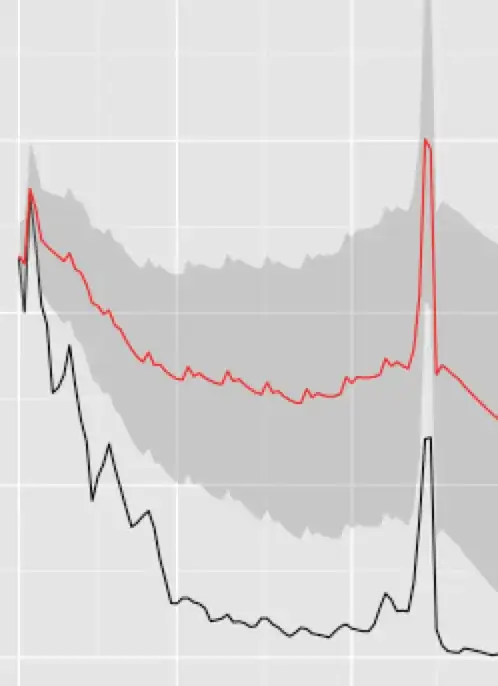This is more of a follow up question regarding: Confused with Residual Sum of Squares and Total Sum of Squares.
Total sum of squares can be represented as:
$$\displaystyle \sum_i ({y}_i-\hat{y}_i)^2+2\sum_i ({y}_i-\hat{y}_i)(\hat{y}_i-\bar{y}) +\sum_i(\hat{y}_i-\bar{y})^2$$
Where:
- 1st term residual sum of squares
- 2nd term is the covariance between residuals and the predicted values
- 3rd term is the explained sum of squares.
There's a few things I don't understand:
- Why would a correlation between residuals and predicted values mean there are better values of $\hat y$?
- Why is the second term covariance? I've tried to solve it on paper, but I'm getting this extra divide by N (number of data points).
$$2\sum_i ({y}_i-\hat{y}_i)(\hat{y}_i-\bar{y})=2\sum_i(y_i \hat y-\bar y_i ^2 + \hat y_i \bar y - y_i \bar y)$$
\begin{align} cov(x, y) & = E[XY]-E[X]E[Y] \\ cov((y_i-\hat y_i), \hat y_i) & = E[(y_i -\hat y_i)(\hat y_i)]-E[(y_i-\hat y_i)]E[\hat y_i] \\ E[\hat y_i] & = \bar y \text{ if perfect prediction} \\ & =E[(y_i-\hat y_i)(\hat y_i)]-E[(y_i-\hat y_i)]\bar y \\ & =E[(y_i-\hat y_i)(\hat y_i)]-E[\bar y(y_i-\hat y_i)] \\ & =E[(y_i\hat y_i-\hat y_i\hat y_i]-E[(y_i \bar y-\hat y_i \bar y)] \\ & =E[(y_i\hat y_i-\hat y_i\hat y_i]+E[-(y_i \bar y-\hat y_i \bar y)] \\ & =E[(y_i\hat y_i-\hat y_i\hat y_i]+E[(-y_i \bar y+\hat y_i \bar y)] \\ & =E[(y_i\hat y_i-\hat y_i\hat y_i-y_i \bar y+\hat y_i \bar y)] \\ & =\frac{\sum_i[(y_i\hat y_i-\hat y_i\hat y_i-y_i \bar y+\hat y_i \bar y)]}{N} \\ \end{align}
From the above computation, $covariance \ne \displaystyle 2\sum_i ({y}_i-\hat{y}_i)(\hat{y}_i-\bar{y})$
I think I'm either misinterpreting or doing something incorrect?
In response to: $H$ is a really important matrix and it's worth taking the time to understand it. First, note that it's symmetric (you can prove this by showing $H^T=H$). Then prove it's idempotent by showing $H^22=H$. This all means that $H$ is a projection matrix, and $H$ projects a vector $v∈Rn$ into the p-dimensional subspace spanned by the columns of X. It turns out that $I−H$ is also a projection, and this projects a vector into the space orthogonal to the space that $H$ projects into.
Let's assume $X$ is a 2x2 matrix:
$$ \begin{bmatrix} 1 & x_1 \\ 1 & x_2 \\ \end{bmatrix} $$
Then $X^T$: $$ \begin{bmatrix} 1 & 1 \\ x_1 & x_2 \\ \end{bmatrix} $$
Compute $X^TX$
$ \begin{bmatrix} 1 & 1 \\ x_1 & x_2 \\ \end{bmatrix} $ $ \begin{bmatrix} 1 & x_1 \\ 1 & x_2 \\ \end{bmatrix} $ $=$ $ \begin{bmatrix} 2 & x_1+x_2 \\ x_1+x_2 & x_1^2+x_2^2 \\ \end{bmatrix} $
Compute $(X^TX)^{-1}$
$ A = \begin{bmatrix} a & b \\ c & d \\ \end{bmatrix} $ $ A^{-1} = \frac{1}{|A|} \begin{bmatrix} d & -b \\ -c & a \\ \end{bmatrix} $ $ A^{-1} = \frac{1}{ad-bc} \begin{bmatrix} d & -b \\ -c & a \\ \end{bmatrix} $
$ (X^TX)^{-1} = \begin{bmatrix} \frac{x_1^2+x_2^2}{2x_1^2+2x_2-(x^2_1+2x_1x_2+x^2_2)} & \frac{-(x_1+x_2)}{2x_1^2+2x_2^2-(x^2_1+2x_1x_2+x^2_2))} \\ \frac{-(x_1+x_2)}{2x_1^2+2x_2^2-(x^2_1+2x_1x_2+x^2_2)} & \frac{2}{2x_1^2+2x_2^2-(x^2_1+2x_1x_2+x^2_2)} \\ \end{bmatrix} $
Compute $X(X^TX)^{-1}$
$X(X^TX)^{-1} = $ $ \begin{bmatrix} 1 & x_1 \\ 1 & x_2 \\ \end{bmatrix} $ $ \begin{bmatrix} \frac{x_1^2+x_2^2}{2x_1^2+2x_2^2-(x^2_1+2x_1x_2+x^2_2)} & \frac{-(x_1+x_2)}{2x_1^2+2x_2^2-(x^2_1+2x_1x_2+x^2_2)} \\ \frac{-(x_1+x_2)}{2x_1^2+2x_2^2-(x^2_1+2x_1x_2+x^2_2)} & \frac{2}{2x_1^2+2x_2^2-(x^2_1+2x_1x_2+x^2_2)} \\ \end{bmatrix} $ $= \begin{bmatrix} \frac{x^2_2-x_1x_2}{2x_1^2+2x_2^2-(x^2_1+2x_1x_2+x^2_2)} & \frac{x_1-x_2}{2x_1^2+2x_2^2-(x^2_1+2x_1x_2+x^2_2)} \\ \frac{x_1^2-x_1x_2}{2x_1^2+2x_2^2-(x^2_1+2x_1x_2+x^2_2)} & \frac{x_2-x_1}{2x_1^2+2x_2^2-(x^2_1+2x_1x_2+x^2_2)} \\ \end{bmatrix} $
Compute $X(X^TX)^{-1}X^T$
$X(X^TX)^{-1}X^T = $ $ \begin{bmatrix} \frac{x^2_2-x_1x_2}{2x_1^2+2x_2^2-(x^2_1+2x_1x_2+x^2_2)} & \frac{x_1-x_2}{2x_1^2+2x_2^2-(x^2_1+2x_1x_2+x^2_2)} \\ \frac{x_1^2-x_1x_2}{2x_1^2+2x_2^2-(x^2_1+2x_1x_2+x^2_2)} & \frac{x_2-x_1}{2x_1^2+2x_2^2-(x^2_1+2x_1x_2+x^2_2)} \\ \end{bmatrix} $ $ \begin{bmatrix} 1 & 1 \\ x_1 & x_2 \\ \end{bmatrix} $ $= \begin{bmatrix} 1 & 0 \\ 0 & 1 \\ \end{bmatrix} $
Is an identity matrix
